.jpg)
/vlcsnap-2012-05-30-15h00m13s182.png)
.png)
.jpg)
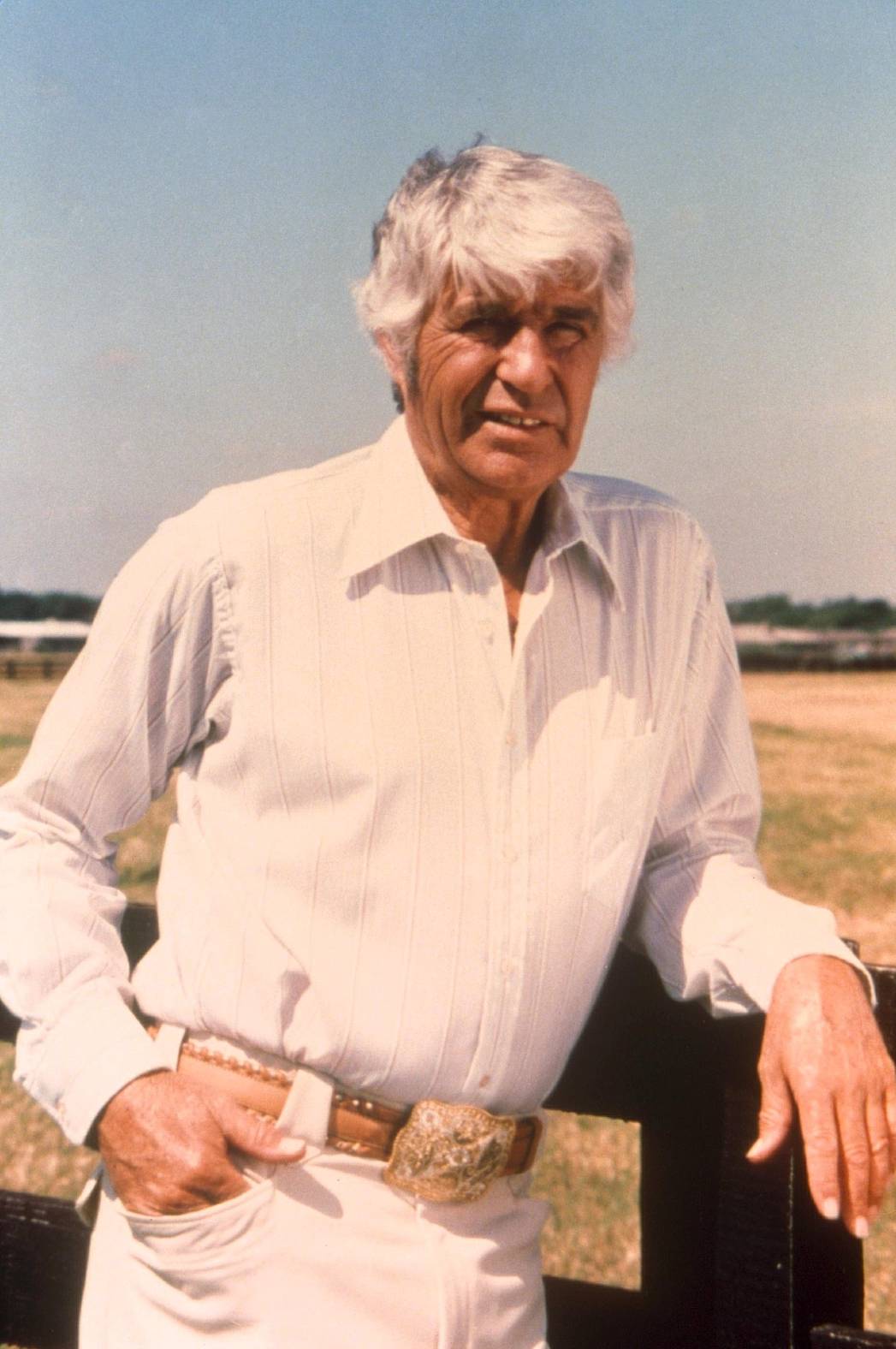
.jpg)
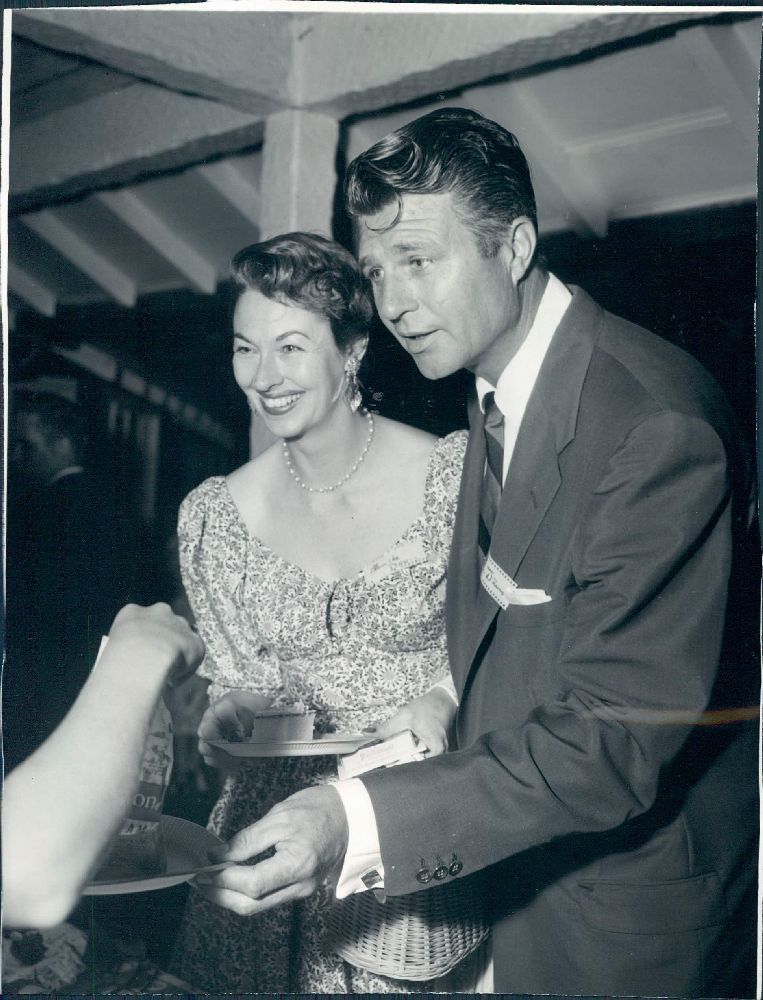
.jpg)
Birth Name: Marlin Otho Davis
Stage Name: Jim Davis
Born: August
26, 1909 in Edgerton, Missouri
Died:
April 26, 1981 in Northridge, California
Cause of death: multiple
myeloma
Star Sign: Virgo
Height: 6'2½/1.89
m
Eye Color: blue
Hobbies and Interest
he liked:
Collecting "western stuff"
Collecting clown figures
horse riding
cooking
Playing golf
Chinese and Mexican food. He didn't like raw fish
Jim liked to collect western memorabilia from the movies and series he was in.
A special item in his collection were three mugs that were given to him by John Wayne.
Wayne had a tradition to give everyone who worked in his movies a special personalized mug.
Wayne created most of the
pictures on the mugs himself and every mug was
personalized to the person it was given to.
%20.jpg)
On the photo we see Jim with his three mugs from the movies
ElDorado, Rio Lobo and Big Jake.
Childhood
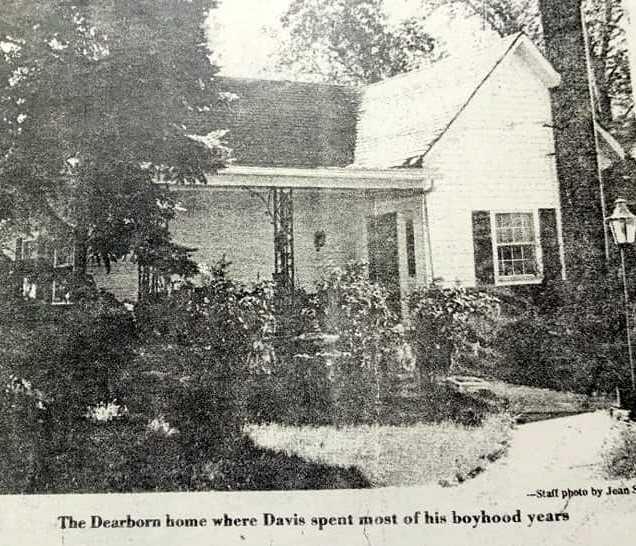
Jim was born on August, 26 1909 as a second child of Lucian and Ethyl Davis in Edgerton, MO.
He had two siblings, his older sister
Jeanette (1907-1987) and one younger named Gladys (1914-2010).
In Dearborn the Family owned and operated the "Davis Funeral Home".
In addition, the family ran a small shop, too.
Lucian Davis was a valued and popular member of the township.
In the mid-1940s, he even held the office of mayor for a while.
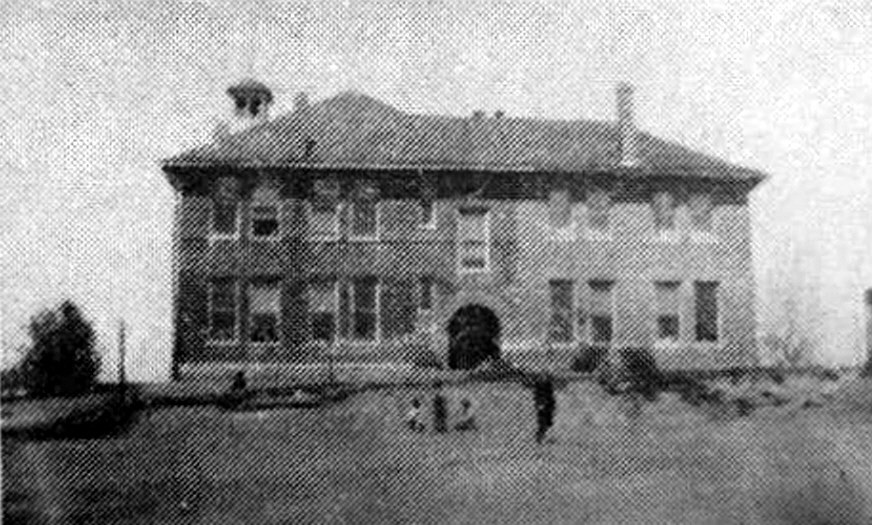
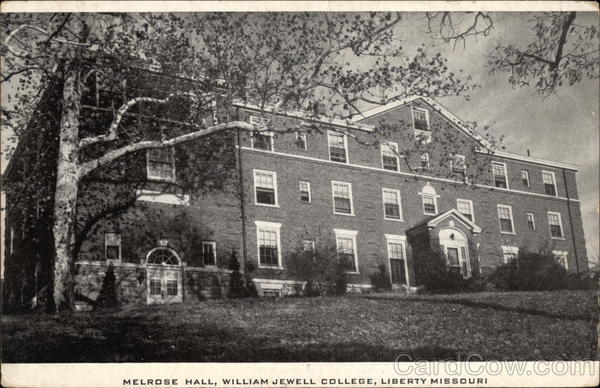
High School William Jewell College
Jim attended the High School in Dearborn, MO.
Jim was highly regarded by both his teachers and his classmates.
His approachable and friendly nature earned him many sympathies.
Later he went to the Baptist-affiliated William Jewell College in Liberty,MO.
Jim was a very successful player in the college football team.
His coaches thought he had great talent for a sports career.
In 1930
Jim graduated in political science.
He was also a member of the Kappa Sigma fraternity.
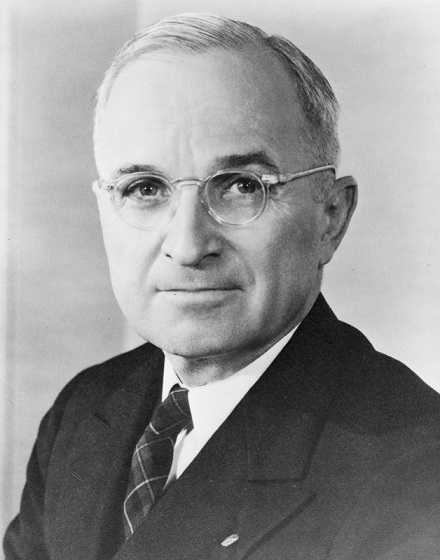
Years later, after his first steps in show business and after his military service Jim was appointed to introduce President Harry S. Truman on the William Jewell College´s graduation program in 1946.
This was a big honor for Jim to be the officell host.
Occupations
Davis' odyssey to acting began when he declined to enter the family business.
Jim Davis: " No way I wanted to be in a mortuary. " he laughs
Before he started working as an actor in 1942 Jim had been working in
many different occupations.
For example at the circus
as a rodeo performer
and in a "Quaker Oats" oat mill.
It soon became clear that he was a very clever speaker and was able to
convince the people well.
In addition he had a very sympathetic personality.
So it was not surprising that he switched from production to sales.
For a short time he tried to work as a car salesman.
Later he worked as
a salesman for the Texas Oil Company "Quaker State Oil".
The latter one was a good job, though this job had no future.
It was around that time that he married his first wife
Betty Norman.
One day they sent him to Hollywood to convince local car dealers to buy
Quaker State Oil.
Whether talent scouts got aware of him or if he started to send in
applications to the studios,
we will probably never be able to find out exactely.
He sent for his girlfriend Jane Campbell and they got married in California. But this marriage was divorced too,
after only eight months and two days. The huge age
difference might have been the problem.
Most newcomers experience extreme difficulties in finding an agent, let
alone a role.
Not Davis, he was quick to find the right man because of his
determination and persuasiveness.
George Ward became his agent who worked for Mitch J. Hamilburg.
This
agency had already made Gene Autry rich and famous.
To get a contract with MGM Jim worked very hard. Impressed by this
diligence and ambition, the film producer
Pandro S. Berman ordered some test shots with Davis.
He let him recite a scene from "Test Pilot". The role had originally been played by Clark Gable.
When studio boss Louis
Mayer saw Davis' test, he decided that this man had everything he needed
to be an actor.
Davis wanted $ 250 a week, a lot of money in those days. Mayer rather
had the modest sum of $ 75 in mind.
But Davis was once again able to convince everyone, he argued, why work for 75 Dollars if he could get 200 Dollars
and a car at Quaker State Oil. He eventually got $ 250 a week.
World War II
Shortly before Jim started his military service at the
Coast Guard, Louis B. Mayer called him to his office.
Mayer promised to get him a role in the new Clark Gable
movie after the war.
He also received a $ 1,000 bonus. After Louis Mayer had
wished Davis good luck, they parted ways.
During his Coast Guard-time Jim had small roles in
various, mostly war-supporting films but the major roles were missing.
After Davis' military service Mayer could not even
remember Jim's name
This made Jim laugh and shortly after he left MGM.
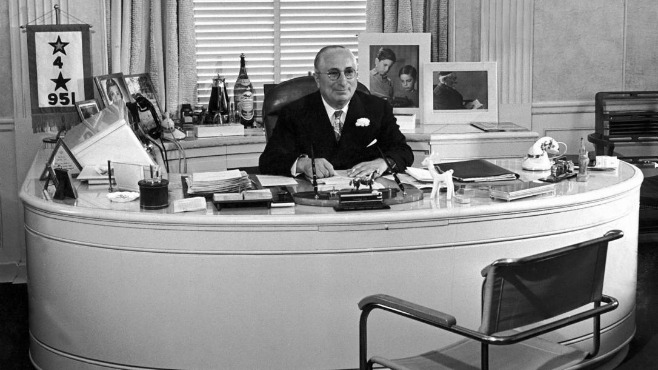
Louis B. Mayer
----------------------------------------------------------------------------------------------------------------------------------------------------
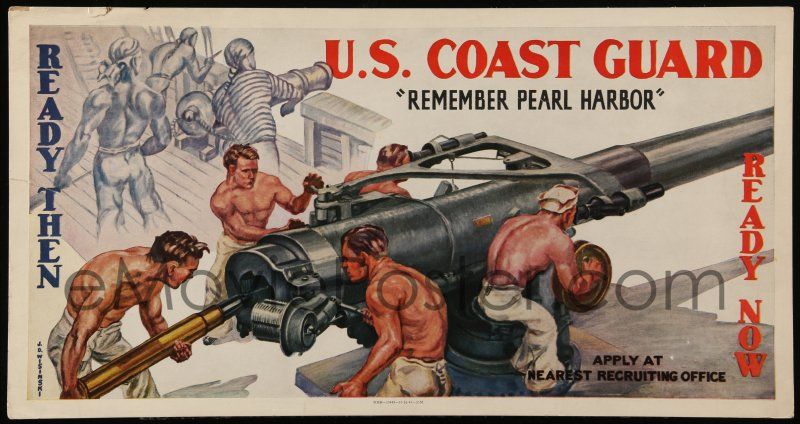
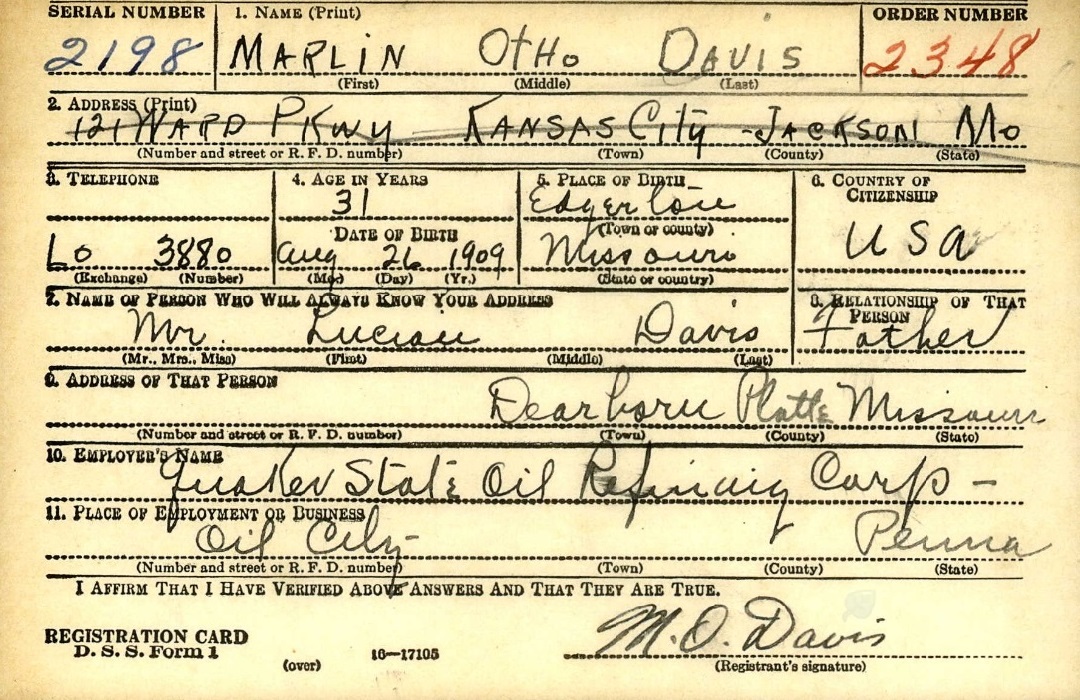
World War II Registration Card of Jim Davis
He served as seaman first class in the United States Coast Guard during World War II.
Enlistment: 15.December.1942
Discharge: 15.June.1945
.jpg)
.jpg)
.jpg)
This information is based on reports
from a family member of a former soldier who is said to have served with
Jim.
Jim Davis did serve on the LST 766
along with my father in February 1945. My dad was serving on Collins
Island in Newport Beach California and travelled to San Pedro to depart
to the Hawaiian Islands. I believe on his trip up to San Pedro the
driver and my dad picked up Jim along the way.
The trip up was pretty eventful when Jim actually convinced the driver
to stop by a Hollywood actress’s place so he could hang out with her for
a few hours. My dad was a few years younger than Jim and really got a
kick out of it. Jim must of been quite the character and a lot of fun to
be around!
Once they reached the Hawaiian Islands Jim had a change of heart and was
able to get out on leave and returned to California. I don’t believe he
served any longer on the LST 766 other than that initial trip.
Since, as far as we know none of the crew members of the LST 766 are
still alive,
no-one will probably ever be able to find out more
The history and role of the U.S.C.G. L.S.T. 766 played in WWII can be
read on Wikipedia.
To what extent Jim was involved in these missions is unfortunately not
known.
All over now?
.jpg)
.jpg)
.jpg)
In 1948 he got the chance to do test shots for the role
of Slick Novak in the new Bette Davis film by Warner Bros.
The competition was tough and the studio favored Richard
Widmark.
But Widmark portrayal of a sadistic killer in the
previous year's "Kiss of Death" movie made it difficult to
accept him in the role of Slick Novak.
Jim was the last of 13 actors who auditioned for the role.
Supposedly Bette Davis jumped in and said Jim had to be
her film partner. Neither the studio nor the director Bretaigne Windust
were enthusiastic about this idea.
Bette Davis issued an ultimatum, either Jim Davis got the
role or she wouldn't do this movie.
At that time, she kept close contact
with Jim Davis and assured him that he would get the role.
In the end he not only got the role, Bette Davis also
advocated that he got the same money as she received.
She was thrilled that she and Davis would be in one movie together and said Jim Davis would one day become
a big star. In this
case this would have meant she had discovered and encouraged him.
Jim Davis believed his dreams were to become true and he
would finally be on top.
In his dreams he already started buying cadillacs.
The honest story about the differences of opinion between
a Catholic and a non-Catholic was a problem for Hollywood.
After all the censorships, the movie ended up being just
a new average drama.
Therefore, it was not surprising that the film became a
flop.
(It cost $1,927,000 to make and took in $1,083,000 at the
box office)
Because they needed a scapegoat, the studio and the
director took the same view to reject any blame.
Later Windust said during filming Jim never showed any
signs of the character he had portrayed in the test shots.
Bette Davis never talked to Jim again.
Surprisingly, the film is now seen as a classic movie.
Since no one wanted to employ a "loser" and the contract with Warner Bros had expired,
Davis had to look for something else.
As he was wandering the streets looking for work, he
talked to a man at a construction site to see if they had work for him.
The man asked for his work experience and Davis replied
that he would do anything.
The next morning he was able to start straight away.
His job was to tow the very heavy concrete slabs for the
new Corinne Griffith Building.
After some time things started going well.
From 1949 on Jim was working as an actor again.
Nevertheless, there were always periods in his life in
which he found no work as an actor.
However, he never complained about this.
Davis once said that he was always working and he was
never sitting on his butt, just waiting.
If he wasn't able to act in films he sold real estate, freezers, hearing aids and much more.
It's getting better

It was not a good year for his carreer, he only had a couple of small roles in movies but it was a good year for love.
Jim met
his later wife
in the late 40s, at the club "Mocambo", on the Sunset Strip.
They were both accompanied by another person, he was
there with a friend of Blanche. After introducing each other, he asked
Blanche for her phone number while dancing. They both met again and fell
in love.
After two short failed marriages, he finally found the
right woman in Blanche Hammerer. They were married for more than 30 years.
In the following years he found his place as supporting
actor in western movies. Jim´s relaxed, easygoing manner and southern
drawl made him the perfect fit for the parts as cowboys. What made his
career special was that he kept changing between good guy and bad-guy
parts in the movies. He was not set on one thing. It was the beginning
of a very productive time at Republic Pictures.
He made a bunch of western movies with well known actors, for example with:
- Three times Oscar winning actor Walter Brennan,
Brimstone (1949).
- Loyd Bridges, Little Big Horn (1951)
- Gene Autry, Silver Canyon (1951)
He also did various films with Rod Cameron and Forrest
Tucker.
Jim
had close friendships with some of the actors such as
James L Brown, their friendship lasted for a lifetime.
Their first film in which they were both starring was "Yes
Sir, That's My Baby (1949)".
Much later the hit series "Dallas" marked the end of
their career, for both of them.
 Jim's
happiest day was when his only child, daughter Tara Diane was born on
January 15, 1953 in the Queen of Angels Hospital in Los Angeles. He and his wife Blanche were very pround of Tara and
they did everything for her.
Jim's
happiest day was when his only child, daughter Tara Diane was born on
January 15, 1953 in the Queen of Angels Hospital in Los Angeles. He and his wife Blanche were very pround of Tara and
they did everything for her.
The enthusiastic horseback rider Davis put his daughter on a horse as early as when she was 4 and dreamed of how his daughter would be winning big tournaments one day.
.jpg)
Television as a new medium provided new opportunities for
Jim.
So in addition to the movies he was now also able to work
in television. It all began when he got smaller but sometimes also
bigger roles in five episodes of the crime series "Dangerous Assignment".
He also starred in four episodes of the western series "Cowboy G-Men"
and he did ten episodes of "Fireside Theatre".
A little movie highlight was a small role in the
Twentieth Century Fox production "The President's Lady" (1953).
He was starring alongside Charlton Heston (who later won an Oscar in 1960).
Not much later things were going to become even better for Jim as the Republic Pictures Studios started planning
on a new western series with Jim in the leading role.
Stories of the Century
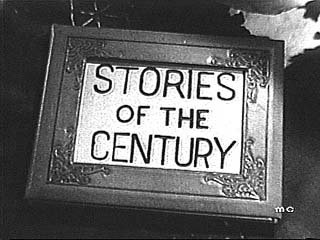
.jpg)
.jpg)
In 1954 Republic Pictures established the television
production arm "Studio City Television Productions".
"Stories of the Century" was the first production they
made, which ran in syndication for 39 episodes from
January 1954 to
March 1955.
They were looking for the right man for the leading part
of the series. It had to be a charismatic man, a man who looked like he
was in the right place. The studio found this man in Jim and so he got
the part of railroad detective Matt Clark despite of having mostly
appeared as bad guys in the movies before. Davis also narrated each
episode.
For the female supporting part Republic had originally
wanted Kristine Mille for the show but at the time, she was expecting
her first baby. So Mary Castle was cast in the role of Frankie Adams.
She played this character for 26 episodes.
Later the studio decided they really wanted to see
Kristine Miller in the show. Now that her baby was six months old she
made it into the series and played Margaret Jones in the last 13
episodes.
The 39 episodes tell fictionalized stories of famous bad
guys.
Matt Clark, who works for the Southwestern Railroad, has
always been tasked with clearing some kind of illegal
connection to the
Southwestern Railroad. Each episode took place in a different time
period and place.
Casting for the outlaws was terrific, some of the best
western actors had guest appearances on the show.
Some examples: Jack Elam as Black Jack Ketchum, Lee Van
Cleef as Jesse James or Marie Windsor as Belle Starr.
The series always looked very authentic. Everytime when
Matt was horse riding, spending a long time on the road he looked dirty
and done. Nobody comes home clean and fine after a two hours ride so the
show was always very good at telling stories in a realistic way.
In addition, Jim totally filled out the role and
apparently became
one with it.
Very often they used outdoor shots and action shots from
other Republic Pictures films.
So they were able to offer the viewer great beautiful
landscapes, chases and more without having to spend much money.
This set the show apart from many other Western series.
The show was something really special and so, well
deserved, the series won an Emmy in 1955 as the first Western series
ever to
receive such an award.
After some time the studio boss of "Republic Pictures",
Herbert Yates decided to switch from Western to another genre. He
thought the time for western was over. That's when they began filming a
new series about a doctor, Fu Manchu. This turned out to be a serious
mistake as the series totally flopped. This led to both series getting
cancelled and shortly after the studio itself was gone.
So this was the end of Jim's first TV hit series which
unfortunately hadn't lasted that long.
Honorary Sheriff of Woodland Hills

Western style - Emulating World War I 'I Need You! slogan, Jim Davis,
urges Mr. and Mrs. Valley Voter to get out and vote June 5, 1956
Jim and some other prominent people were installed as various honorary officials at the San Fernando Valley Country Club in Woodland Hill. The ceremony was held at an annual dinner of the Chamber of Commerce in 1955.
Jim was installed as the honorary Sheriff of Woodland Hills by Douglas Pedlow jr. It was an enjoyable evening with music, comedy skits and more. Highlights of the evening was a speech by assemblyman Pat McGree. Attending the evening were among others Councilman Robert Wilkinson with his wife and Harry Warner, of Warner Brother Studios and his wife.
In 1956 and 1957 Jim received the same honor again. He remained an
honorary sheriff for another two years.
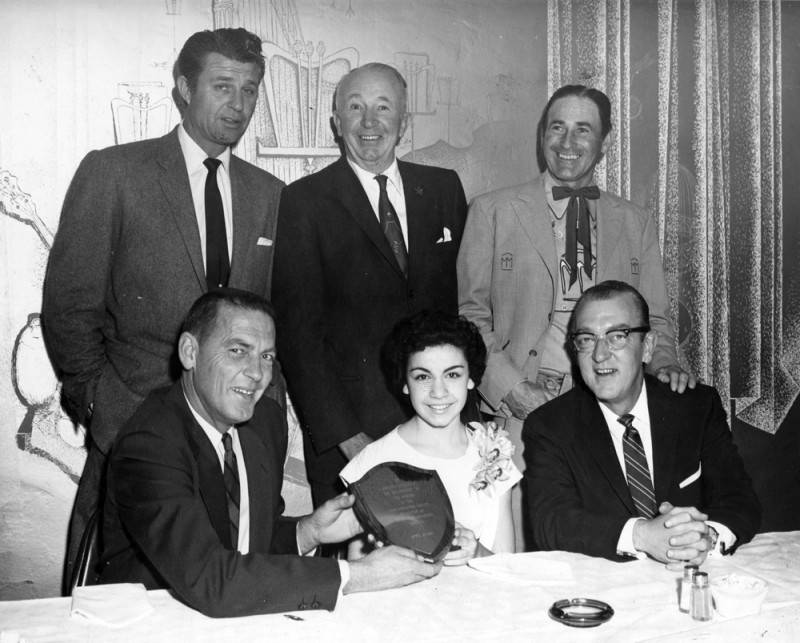
May 2, 1957
Annette Funicello, member of Walt Disney Mouseketeers, accepts plaque naming her
'Sweetheart of San Fernando Valley Honorary Mayors.'
From left are, seated, 'Mayors' Paul Pierce, Tarzana; Gene Baker, Granada Hills; standing Jim Davis, honorary sheriff, Woodland Hills; 'Mayor' Walter Brennan, Panorama City, and 'Mayor' Monty [sic] Montana, Northridge.
Presentation was at Tambour Restaurant in Tarzana.
Finally on the TOP
.jpg)
"Stories of the Century" was very popular but the studios cancelled it.
Yet, these 39 episodes increased Jim's popularity enormously.
During the production of the series, he was playing a few minor roles in various films. But after the series Jim's roles grew bigger.
He was now a lead actor. Some of his first lead acts were non-Western films like "Blonde Bait" (1956) and the sci-fi/horror movie "Monster from Green Hell" (1957). No masterpieces but the films found their viewers.
Much better were the Western films in which he now appeared as a star of
the movie. You can notice that these films and the image of what they represent, fit better.
A small selection:
Last Stagecoach West (1957 reunited with his serial mate Mary Castle)
Raiders of Old California (1957 a movie with historical mistakes but interestingly, he
played a bad guy in the leading role)
The Badge of Marshal Brennan (1957)
Wolf Dog (1958 a modern times western)
A Lust to Kill (1958)
Noose for a Gunman (1960)
/The%20Badge%20of%20Marshal%20Brennan%20(2)%20Jim%20Davis.jpg)
Another little movie highlight was the comedy western
"Alias Jesse James (1959)", starring Bob Hope in the leading role. Both
actors combined a passion for golf. In 1983 Hope was inducted in the World Golf Hall of Fame
because of his big contributions to golf sports. He held regular tournaments in which Jim also
participated.
Of course, he also continued to appear in various series. One deserves a special mention: Dezernat 'M'. This crime series, starring Oscar winner Lee Marvin
reunited Jim for an episode with Kristine Miller.
Something very special about the show: Jim had a dual
role in it.
A new chapter in Jim's TV career was about to begin. The year 1958 brought him a new leading role in a series.
Rescue 8
/Jim%20Davis%20Rescue%208.jpg) Screen Gems produced the series "Rescue 8" from September
1958 to May 1960, for two seasons.
Screen Gems produced the series "Rescue 8" from September
1958 to May 1960, for two seasons.
It was an action drama series about a Los Angeles County
Fire Department Rescue Squad 8.
The show ran in syndication for 74
half-hour long episodes. "Rescue 8" was very popular so nobody was surprised that
syndicated reruns continued for almost a decade. The Rescue 8 team was mostly seen in physically oriented
rescues.
Once again, Jim was convincing and the producers chose
him for the role as fireman Wes Cameron.For the supporting part they cast Lang Jeffries as the
fireman Skip Johnson.
As recurring roles they also casted Nancy Rennick and
Mary K. Cleary as Patty Johnson and Susan Johnson, the wife and daughter
of Skip Johnson.
Jim narrated parts of the episodes again.
The series was very popular and had some good guest stars.
Some examples: Patricia Blair, John Carradine, Richard Chamberlain,
Michael Dante,
Robert Redford and Harry Dean Stanton.
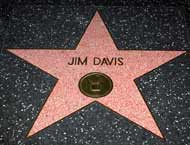
The series raised Jim's popularity again. This time, even non western fans were paying attention to him. His continuing stardom was also proven by the fact that he got one of the first of 1500 stars on the Walk of Fame. At this time, it was not such a big deal. Although this award only gained in importance over the years, it was a first mention of his achievements in film business. Today, millions of people are visiting the Walk of Fame every year.
TV Commercials
Jim's rising popularity opened another type of offer, TV
commercials.
As TV became more and more popular many companies were
starting to use it for their own purpose.
So they became aware of him and increased Jims reputation
through their products.
For many great actors the advertising business was a "no
go". They were afraid their career would suffer.
They thought it was under their dignity to do something
like this.
Jim had always seen this pragmatically. Why make a movie
that takes weeks to finish if he could as well get $ 3,000 for a single
TV commercial? One of the first products Jim did advertising for was the
"Buick Wildcat" (1964). Over the years other very lucrative offers were
following. For example "Coffee Mate" and "Winn Dixie".
The great Era of TV Series
In the 60s, Jim worked mainly in TV business with a few
exceptions that include many successful and famous series :
.jpg)
The Tall Man (2 episodes), Wells Fargo (3 episodes), Laramie (4 episodes),
Have Gun-Will Travel, Wagon Train (4 episodes), Bonanza (3 episodes),
Daniel Boone
(3 episodes), The Guns of Will Sonnett (starring
Walter Brennan and Dack Rambo who would later star in the cast of Dallas),
Some of Jim's non western series include:
Time Tunnel,
Hoppla Lucy! , Perry Mason (2 episodes)
The Donna Reed Show (Donna would also star on Dallas many
years later) and Lassie.
.png)
Not only his TV series showed a great variety but also
the movies he was shooting at the time. With increasing age and slightly graying hair, the roles
for which he got cast changed.
For example he was seen as the father of a little boy in
the wonderful family movie "Zebra in the Kitchen".
But even the simple Korean war movie "Iron Angel" still
has a great reputation among his fans up until today.
And then Jim also shot some western movies again
including one of his best western films as a lead actor in "The Gambler
Wore a Gun" (1961). Another film highlight is "El Dorado" (1967). This
was the first movie in which he played alongside John Wayne. Both actors
got on very well and so they stayed in contact with each other after the
filming.
A few years later Wayne would do something very special for Jim as he helped him process a very tragic loss.
Tragic Loss
.jpg)
In 1970 he had to cope with the biggest loss of his life.
His daughter had a terrible car accident, just weeks
before her high school graduation. Her injuries were so severe that she
could only be kept alive on a life support mashine.
Jim had to make the hard decision to remove her from life
support or not. Davis opted for the latter because there wasn't much
hope she would ever wake up.
So he thought his daughter had the right to die in dignity.
Tara was only 17 years old and was laid to rest at Forest
Lawn Memorial Park in Glendale, California.
For many years, neither he nor his wife Blanche were able
to talk about it. Both found comfort in their faith in God.
Jim also spent a lot of time in the garden of his house.
He
never was embittered, in his opinion he had a very lucky life. And
tragic and bitter moments belong to life as well.
.png)
Despite all of this Jim never gave up. Life had to go on.
He also received a lot of support from various colleagues,
including John Wayne who helped him to get smaller roles
in some of his movies.
Also physically, this heavy loss left its mark. It seemed
like he
had aged years in a very short time. Jim's hair became gray
and he also added a few pounds.
Moving on
The following years
brought a great variety of work for Jim.
He was seen again in popular western series like Gunsmoke (11 episodes)
or Kung Fu (2 episodes).
But the big era of western series was over. More and more people wanted to see other formats.
This gave Jim the chance to play other parts than sheriffs and cowboys.
.jpg) He
was in "The Streets of San Francisco" (2 episodes) starring Oscar winner
Karl Malden and Michael Douglas. He was also in "The Blue Knight" (1
episode) starring Oscar winner George Kennedy who was later a star on
Dallas.
He
was in "The Streets of San Francisco" (2 episodes) starring Oscar winner
Karl Malden and Michael Douglas. He was also in "The Blue Knight" (1
episode) starring Oscar winner George Kennedy who was later a star on
Dallas.
1974 he was cast in the short lived series "The Cowboys".
The series was based on the John Wayne movie with the same name.
Only 12 episodes were produced before the series was canceled. This should not be the only failure in the next years.
One year later Jim was co-starring in the movie "The
Runaway Barge".
He played the captain of a Mississippi river tugboat who started drinking after the death of his beloved wife.
After a little adventure he found new hope and began a new life.
The movie was the pilot for a TV series called "Rivermen". But the series was not ordered.
.jpg) Jim
guest starred in other more or less well-known series like "Project
U.F.O.", "The Oregon Trail", "The Quest" and "Banacek" starring George
Peppard.
Jim
guest starred in other more or less well-known series like "Project
U.F.O.", "The Oregon Trail", "The Quest" and "Banacek" starring George
Peppard.
Things were going
similarly in Jim´s film work.
Jim co-starred alongside Oscar winner Jeff Bridges in the great western
movie "Bad Company" in 1972.
He also had a small part as a senator in "The Parallax View" in 1974.
Years later after
Rescue 8 Jim played a rescure man again: As fireman Rocky Stratton in
the 1974 movie "Inferno in Paradise". Other good movies he made in this
time were "Satan's Triangle" in 1975 and "Killing Stone" in 1978.
The latter was a movie written and directed by Michael Landon.
Both actors had worked together on Bonanza many years ago.
.png)
The decade was coming to an end and one of Jim's last works was a
supporting part in "Comes a Horseman" in 1978 starring oscar winner Jane
Fonda. An other part he had was as a lead actor in the family
science-fiction movie "The Day Time Ended" in 1979.
It was a
special-effect movie without a good story.
Nobody expected that a minor role in a mini series was about to change
everything.
Dallas
International Fame as "Big Daddy"
.jpg)
At the end of the 70s David Jacobs had the idea for a
drama series about a rich family in the oil business.
Michael Filerman, a partner of Jacobs, suggested to
choose the city of Dallas in the state of Texas as the location for this
series since the city was an importent center of the U.S. oil industry
at the time.
It was planned to make a five-part mini series which was
later screened on CBS.
Initially the producers had no plans for a regular series.
For the role of John Ross "Jock" Ewing, the head of the
family, the producers wanted a John Wayne typ of actor.
Everyone was aware that John Wayne would not do a TV show
becauce he was too ill and also a big movie star.
Once again, they rememberd Jim, who had been cast many
times before for roles with this characterization.
When Davis read the screenplay, his wife Blanche said to
him that this role was perfect since he didn't even have to act,
he could just be like he was at home.
For his series wife Eleanor "Miss Ellie" Ewing they cast
Oscar nominee and stage legend Barbara Bel Geddes.
Both are said to have been cast without big auditions
because it was difficult to imagine other actors for these roles.
.png)
In addition they cast Larry Hagman as his oldest son John
Ross "J.R" Ewing, Patrick Duffy as his younger son Bobby Ewing, Victoria
Principal as Bobby's wife Pamela Barnes Ewing who was the daughter of
Jocks rival Digger Barnes. Carlene Tilton played Lucy Ewing, daughter of
Jock's son Gary Ewing.
The theme of the series was the rivalry between the Ewing
and the Barnes families. The feud started out with Jock and Digger and
their first big oil deal and was later reawakened with the marriage of
Bobby and Pamela.
But the family feud wasn't the only theme, Dallas was a
show about wealth, sex, intrigues, conflicts and power struggles.
The mini series was a hit. It was 44 in the Nielsen TV
ratings.
The producers decided to make the mini series into a
regular series.
Once the show became a regular series more and more
characters started to join the main cast.
Among them were Linda Gray as J.R.'s alcoholic wife Sue
Ellen, Steve Kanaly as ranch hand Ray Krebbs (and Jock's illegitimate
son) and Ken Kercheval as Pam's brother Cliff Barnes.
Dallas became more and more popular over the years. In the Nielsen ratings they rose from 44th place to 15th place,
later to 6th place, until they even climbed to the top in year 4. The number of countries in which the series was
broadcast also increased. With a broadcast in over 130 countries, Dallas became one of the most successful series in
terms of viewership.%20-%20Kopie.jpg)
The cliffhangers were one of the reasons why the show was so popular and this continued to increase interest among the audience. There have been many in the history of the series but the most sensational and exciting one was
"Who shot J.R.?". For almost a year the
fans were guessing who had shot J.R. Ewing, in all circles of society. Even the British royal family were glued to their TVs.
At a reception, Queen Mum asked Larry Hagman to please
tell her who shot J.R.
He denied this because the actors themselves didn't know the answer to it.
Many different actors had filmed a shooting scene, including Jim as Jock. The scene opens up with him telling his son: "Take this, you son of a bitch". One can assume that the producers never really intended to use this recording. Who would have liked to see Jock call his beloved Miss Ellie a bitch!
The actors of the show got on extremely well. They really became a small family over the years. Everyone had a lot of fun with their work. Maybe also a secret why the series became so good and popular. It wasn't just a job for them, it was something special. Jim used to refer to himself and Barbara Bel Geddes as the "old" generation. When the younger actors were joking around, he and Barbara were often sitting a little apart and he would jokingly said "We have to show our professionalism and our seriousness ". Both connected a friendship that was also continued privately. They would visit each other occasionally and stayed in contact.
Due to the good relationships between all the actors,
they had many interesting conversations during the shooting of Dallas.
Larry Hagman and Patrick Duffy in particular listened eagerly when Jim
talked about his numerous western films.
It seems to both of them as if Jim had shot thousands of movies with the
number of anecdotes and memories he shared.
Hagman who was a few years older than Duffy, still remembered very well
how he admired Jim on TV in the 50s.
So it was a special honor for him to be able to work with him on Dallas.
Nobody was surprised that after the series had ended, Hagman took home the painting of Jim as Jock Ewing and hung it in the entrance area at his house.
.bmp)
The international fame of Dallas changed the life for Jim and Blanche a lot. There was hardly a place where they could go without Jim being recognized. It was not new for him to be recognized, but not to this extent. But he enjoyed it very much. There was no autograph request he refused or a person for whom he did not have a smile and a greeting. His joy about this success went so far that he got the license plate "Ewing 1" for his private car. However, he had to have this changed again after a while, as some fans went so far and pursue him..
To top it all, mountains of letters from a wide variety of fans reached him. The range went from autograph requests to
the
offering of dates. It seems that all this is the reward for his decades
of work in the second row.
Since the success of the series also resulted in a
certain financial success, Jim could now fulfill some of their wishes
that would otherwise seem unreachable. So they both traveled to Europe
for the first time and visited various cities such as London and Paris.
And everywhere enthusiastic Dallas fans were waiting for him.
But as so often in his life, this happiness should not
last too long.
Ilnes
For many years, Jim was suffering from an unbearable headache.
But showing "weakness" and going to the doctor was not an
option for him.
When he decided to go to the doctor, it was already too
late. An incurable brain tumor was diagnosed.
Even then he was narrow-minded and in no way willing to
undergo treatment.
Jim had a clear opinion of his wife showing up on the set. He didn't want her to visit him.
Jim's opinion was that if he was
working in a department store, she wouldn't come to see how he got on
with customers.
This did not change when he found it increasingly
difficult to continue working. Blanche was only allowed to visit him if
it could not be avoided. To help him with the oxygen mask or to remind
him that it was time for his medication.
At that time, he spent most of the time between scenes in
his wheelchair from which he only got up when it was his turn.
But to stop working was not an option for him. He had
promised to work until the end of the season and Jim wanted to keep that
promise.

The producers became increasingly aware that Jim would not be
able to continue working for long. Therefore, they decided to
reject the planned separation of Jock and Miss Ellie.
The storyline around the Takapa project was also ended at short notice. The remaining time was used to show how Miss Ellie and
Jock reconciled. Both were sent
on a trip to explain Jock's absence.
So the last time we saw Jock Ewing was the moment he was
sitting
in a car saying goodbye to his family.
Nobody knew that this would be a final separation.
It was actually planned that Jock would return after Jim's recovery.
The upcoming gastric ulcer surgery,
a complication of the tumor, was one of the things that you thought was
not a risk.
But paradoxically, that was what brought the end.
Jim spent his last days at his home in Glendale with the
help of a nurse and his beloved wife Blanche took care of him after the
gastric ulcer surgery. Most of the time he was asleep and initially it
looked like he was going to recover.
Nevertheless, Jim Davis died on April 26, 1981 while
napping in his sleep.
Funeral
.jpg)
.jpg)
Many prominent people were present at Jim's funeral. These included
colleagues and friends such as Dallas cast members Barbara Bel Geddes,
Victoria Principal, Linda Gray, Susan Howard, Charline Tilton, Keenan
Wynn and Leigh McCloskey. Patrick Duffy and Larry Hagman were some of
the few of the Dallas cast who were absent. Both were prevented and did
not make it back in time. Colleagues from previous productions also
wanted to pay their last respects. Among them were Ernest Borgnine and
James Cobum. And of course friends like Alan Hale Jr were present as
well.
Other expressed their condolences in written form.
e.g. Kirk Douglas, Wanen Beatty, Richard Widmark, Henry Fonda, Bob Hope, Robert Mitchum
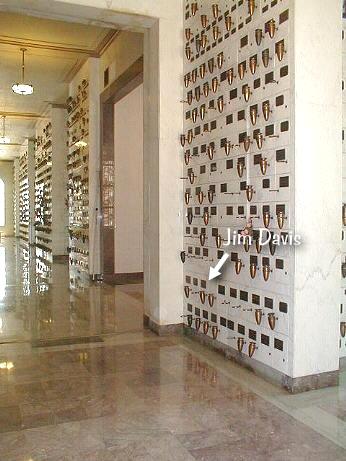
.jpg)
Jim was laid to rest in the Forest Lawn Memorial Park in Glendale, California.
His grave is located at the Great Mausoleum. Jim shares his grave with his only daughter Tara Diane who was buried 11 years before him.
With the death of Blanche Davis in 2009 parents and daughter were
reunited in the family grave. The Great Mausoleum is closed to the public.
.jpg)
.png)